APAC Hard Facility Management Market Size
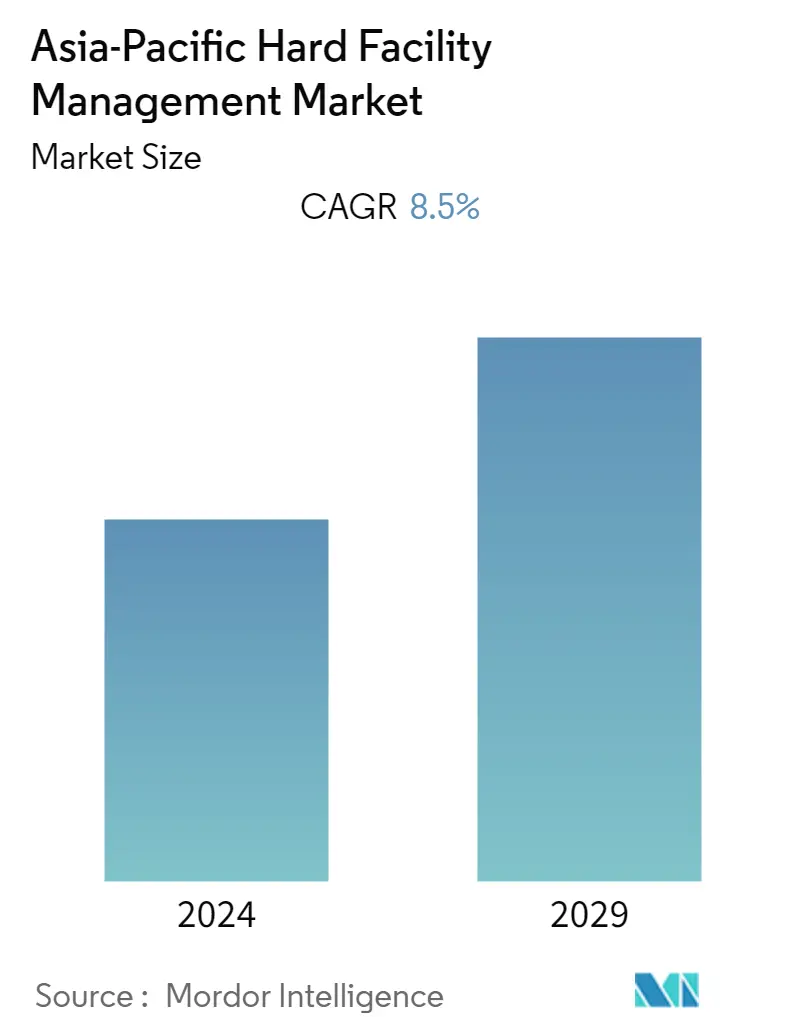
| Study Period | 2019 - 2029 |
| Base Year For Estimation | 2023 |
| Forecast Data Period | 2024 - 2029 |
| Historical Data Period | 2019 - 2022 |
| CAGR | 8.50 % |
| Market Concentration | Low |
Major Players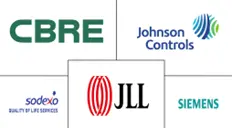
*Disclaimer: Major Players sorted in no particular order |
APAC Hard Facility Management Market Analysis
The Asia-Pacific hard facility management (HFM) market revenue is expected to record a CAGR of 8.5% over the next five years. The market is anticipated to continue growing due to the increased urbanization and population in the region.
- To find ways to combat air pollution in Asia-Pacific, the Economic and Social Commission for Asia and the Pacific (ESCAP) of the United Nations hosted several knowledge-sharing workshops. These discussions centered on enhancing regional collaboration and facilitated a wider interchange of creative approaches to reducing air pollution and best practices, including necessary regulations, data, and technology. HVAC systems are crucial to maintaining high interior air quality with sufficient ventilation and filtration. HVAC cleaning services are necessary to clean and maintain the ventilation ducts, filters, chimneys, and other system components from dust, debris, and germs.
- The increased potential expansion of retail, commercial, and residential is expected to propel the Asia-Pacific facility management industry in the next six years. The region is primarily driven by an increase in industrial and building activity, particularly in the commercial sector, which is backed by several government programs like the "Smart City Mission of India." The growing several commercial buildings in India, China, and Singapore are giving rise to the demand for hard facility services from construction design and fire equipment to escalator maintenance.
- Since the pandemic's start, macroeconomic and geopolitical headwinds have put pressure on distribution networks and exposed weaknesses in supply chains throughout the Asia-Pacific, with the region's heavy equipment and HVAC facility maintenance services being among those most impacted. Because construction supplies are more difficult to get and need longer lead times, these supply chain bottlenecks are considerably lengthening the schedules for commercial build-out and occupant improvement projects throughout the area.
- Furthermore, growth in tourists, particularly from Southeast Asian nations like Thailand, Indonesia, the Philippines, Malaysia, India, and Maldives, is supporting the growing hospitality sector. The growing demand for tourist accommodations has created opportunities for hiring a facility management team, which is held accountable for managing hotel properties and tourist amenities. This prominent role played by facility management is anticipated to positively affect the growth of the Asia-Pacific facility management market over the forecast period.
- After the epidemic, regulations still encourage proper cleanliness practices. Included in these procedures are the placement of hand sanitizers in all public places, an increase in office ventilation, and air purification. Other safety precautions include face mask zones, a one-way system, and social seclusion by designed light weigh cubicles. It would be incumbent on facility managers to maintain these standards going ahead and to make sure that all precautions are taken.
APAC Hard Facility Management Market Trends
This section covers the major market trends shaping the APAC Hard Facility Management Market according to our research experts:
Growth of Commercial Construction
- With the fast expansion of facility management outsourcing in several emerging regions, the Asia-Pacific HFM management market is expanding at an astonishing rate. Despite the economic difficulties, the Asia-Pacific building industry saw strong growth last year. In developed economies, demand for residential development remained high. On the other hand, infrastructure development saw more significant investment, and local construction firms moved into new markets. New investments in the Asia-Pacific commercial building sector have bolstered the facilities management sector.
- The infrastructure and construction industries are quickly expanding in emerging nations, and as a result, the HFM business is now witnessing a growing demand from various industrial sectors. Given that the infrastructure industry in the Asia-Pacific is predicted to increase, this expansion trend may be seen significantly throughout the area. Building materials, engineering, and construction are essential to post-pandemic rehabilitation for communities and economies.
- The Nationwide Smart Cities Mission is an urban rehabilitation and renovation initiative by the Government of India to create sustainable, smart cities across the nation. The industry initially targeted 100 cities, and the projects had a 2019-2023 completion window. Building ecological spaces, planned, articulated, and technologically compatible solutions with the assistance of information technology in the quest for increased efficiency is the long-term objective of smart city solutions, which can be efficiently addressed with the help of construction facility engineers in the country.
- In China, a significant uptick in building output is anticipated for last year. Also, China's commercial building industry is expected to overtake all others during the next decade. Moreover, there is an escalated rise in road and rail projects in Australia and Japan. The Southeast Asian region would witness a surge in construction due to the demand rise in the hotel industry. All this accumulated demand would boost the need for heavy machinery and HVAC services for the ongoing new building and projects.
- These statistics from the National Bureau of Statistics of China illustrate the production value of the construction sector in China from 2011 to last year, showing the industry's steady expansion. The value of China's building production peaked last year at roughly 29.3 trillion yuan.
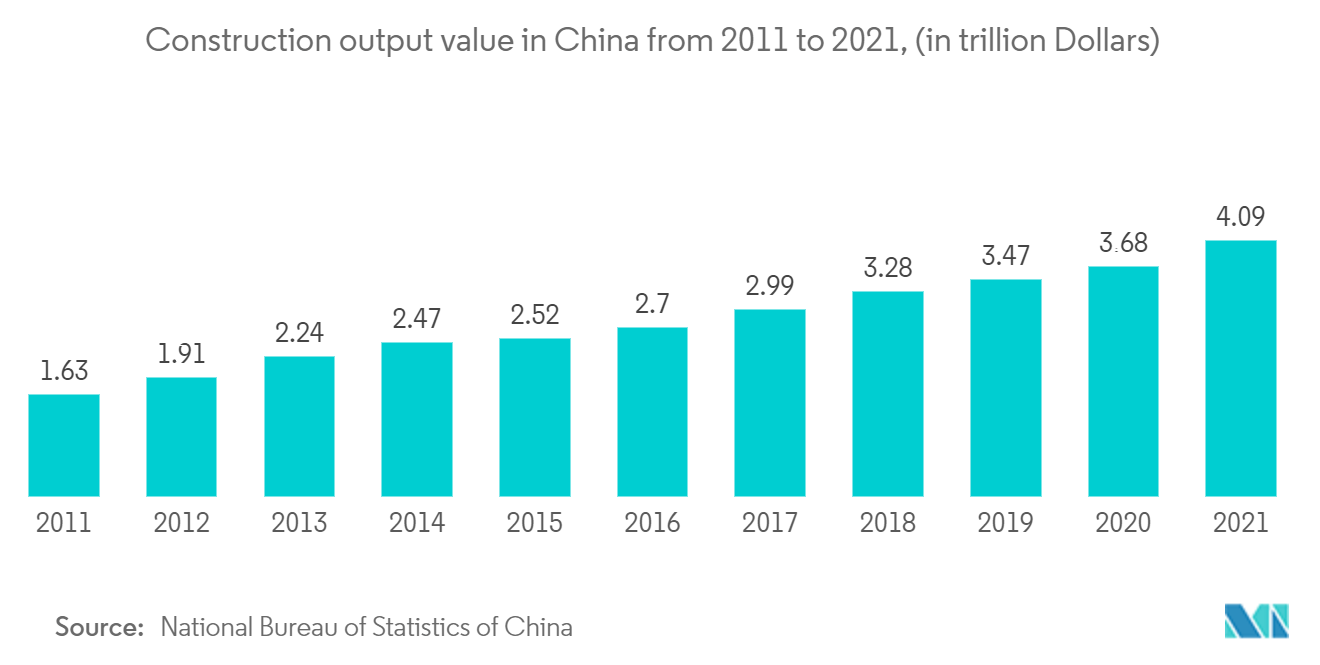
Rebound of Hospitality Sector in Southeast Asia
- As borders reopen and operating performance returns to pre-pandemic levels, confidence in the Asia-Pacific hotel and hospitality industry is rising. The hotel business in South-East Asia appears to be quite promising, with Thailand, Vietnam, and Indonesia developing quickly, according to Tophotelprojects. According to the research, 568 hotel projects totaling 159,216 keys are planned for South-East Asia over the next two years. 352 of the 568 planned hotels would be four-star establishments, while 216 are five-star establishments.
- The fast growth of the building and construction sector due to increased commercial construction in this region is driving the HFM. The electrical and civil engineering services and the HVAC installation and maintenance from the new hospitality constructions are rising in Southeast Asia. Also, the rising construction of shopping centers and retail establishments is advancing the industry. This would cause a rapid demand hike in escalators, lift maintenance, and other hard facility services.
- Furthermore, post-covid HVAC Systems maintenance in hotels, malls, and regional entertainment centers are of utmost importance. The World Health Organization's recommendations state that there is still a great danger of SARS-CoV-2 airborne transmission inside. Safety professionals, building managers, and others may optimize a facility's airflow and ventilation to prevent the spread of viruses. Business owners prioritize maintaining the HVAC system to ensure proper filtration and ventilation are always maintained.
- New hotels are more likely to include high-quality fire protection, detection and alarm systems, and fire sprinklers in each guest room. If any smoke alarms are present, they may only be in older hotels' guest rooms. In contrast to restaurants and other comparable attractions, hotels do not emphasize fire safety. However, fire safety is a legitimate concern. A fire-safety facility manager can help create a fire prevention plan appropriate for the situation. Regarding training, equipment maintenance and protection, and legal and ethical requirements, it ensures that it is at par with all national and state fire safety legislation and standards.
- The number of hotels and other such businesses grew significantly in Indonesia from 2012 to last year. About 3.52 thousand hotels and other similar facilities existed in Indonesia in 2021, according to UNWTO data. However, last year, there were about 100 fewer of these businesses than the previous year.
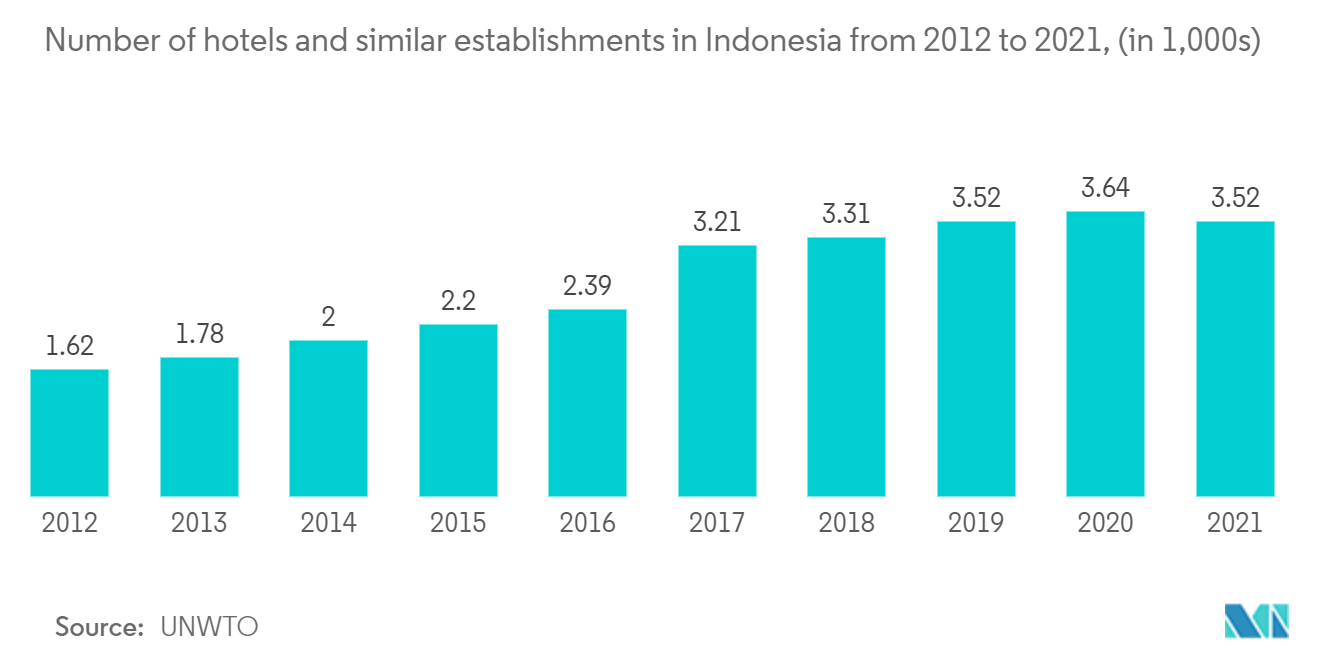
APAC Hard Facility Management Industry Overview
The Asia-Pacific Hard Facility Management (HFM) is fragmented, with local and international players having decades of industry experience. The HFM vendors are incorporating technologies into their services, strengthening their service portfolio. The major players are Sodexo, Inc., Jones Lang LaSalle Incorporated (JLL), CBRE Group Inc, Johnson Controls International, and Siemens AG.
- In May 2022, CBRE expanded its presence in India and launched operations in Jaipur. The new office would act as the contact point for the expanding clientele in northern India.
- In January 2022, Aden Group and TotalEnergies formed a partnership to evaluate various cooperative possibilities for exchanging and delivering cutting-edge solutions to lower the carbon footprint of constructed assets using solar energy and data-driven energy optimization.
APAC Hard Facility Management Market Leaders
-
Jones Lang LaSalle Incorporated (JLL)
-
Sodexo S.A.
-
CBRE Group Inc
-
Johnson Controls International
-
Siemens AG
*Disclaimer: Major Players sorted in no particular order
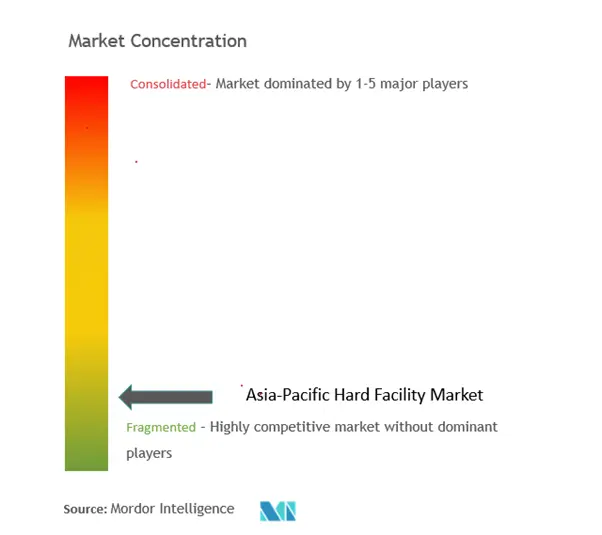
APAC Hard Facility Management Market News
- July 2022: JLL India entered an agreement with Tata Power to campaign for green energy solutions in the real estate sector. Given that the real estate industry is responsible for around 40% of all greenhouse gas emissions, the industry must adopt green energy.
- August 2022: ISS, a premier provider of workplace experiences and facilities management, announced that it had purchased Livit FM Services AG, a facility management firm in Switzerland, from its parent company, Livit AG. In the first quarter of 2023, the merger of the purchased firm is anticipated to be finished.
APAC Hard Facility Management Market Report - Table of Contents
1. INTRODUCTION
- 1.1 Study Assumptions and Market Definition
- 1.2 Scope of the Study
2. RESEARCH METHODOLOGY
3. EXECUTIVE SUMMARY
4. MARKET INSIGHTS
- 4.1 Market Overview
-
4.2 Industry Attractiveness-Porter's Five Force Analysis
- 4.2.1 Bargaining Power of Suppliers
- 4.2.2 Bargaining Power of Consumers
- 4.2.3 Threat of New Entrants
- 4.2.4 Threat of Substitute Products
- 4.2.5 Intensity of Competitive Rivalry
- 4.3 Impact of COVID-19 on the Hard Facility Management Industry
5. MARKET DYNAMICS
-
5.1 Market Drivers
- 5.1.1 Growing Commercial Construction in the region
- 5.1.2 Escalated Demand for HVAC Services
-
5.2 Market Restraints
- 5.2.1 Supply Chain Disruption in the Region
-
5.3 Key Base Indicators of the Market
- 5.3.1 Growth of Commercial Construction Sector
- 5.3.2 Rebound of Hotel Businesses
6. MARKET SEGMENTATION
-
6.1 By Type
- 6.1.1 MEP (Mechanical, Electrical, Plumbing), and HVAC Maintenance services
- 6.1.2 Enterprise Asset Management
- 6.1.3 Other Hard FM Services
-
6.2 By End User
- 6.2.1 Commercial
- 6.2.2 Institutional
- 6.2.3 Public/Infrastructure
- 6.2.4 Industrial
- 6.2.5 Other End Users
-
6.3 By Geography
- 6.3.1 Australia
- 6.3.2 China
- 6.3.3 India
- 6.3.4 Japan
- 6.3.5 Indonesia
- 6.3.6 Malaysia
- 6.3.7 Singapore
- 6.3.8 South Korea
- 6.3.9 Taiwan
- 6.3.10 Thailand
- 6.3.11 Rest of Asia-Pacific
7. COMPETITIVE LANDSCAPE
-
7.1 Company Profiles
- 7.1.1 Jones Lang LaSalle Incorporated (JLL)
- 7.1.2 Sodexo S.A.
- 7.1.3 CBRE Group Inc
- 7.1.4 Johnson Controls International
- 7.1.5 Siemens AG
- 7.1.6 Aden Group.
- 7.1.7 Volvo CE
- 7.1.8 Honeywell International Inc.
- 7.1.9 Fujitsu Limited
- 7.1.10 NCH Asia Pacific
- *List Not Exhaustive
8. INVESTMENT ANALYSIS
9. FUTURE TRENDS
** Subject To AvailablityAPAC Hard Facility Management Industry Segmentation
Hard Facility Management (HFM) services manage the technology, systems, and equipment that make up a company's physical structure.
The Asia-Pacific HFM market is segmented by type (mechanical, electrical, plumbing (MEP) and HVAC maintenance services, enterprise asset management, and other HFM services), end user (commercial, institutional, public/infrastructure, industrial, and other end users), and geography. The market sizes and forecasts are provided in terms of value (USD million) for all the above segments.
| By Type | MEP (Mechanical, Electrical, Plumbing), and HVAC Maintenance services |
| Enterprise Asset Management | |
| Other Hard FM Services | |
| By End User | Commercial |
| Institutional | |
| Public/Infrastructure | |
| Industrial | |
| Other End Users | |
| By Geography | Australia |
| China | |
| India | |
| Japan | |
| Indonesia | |
| Malaysia | |
| Singapore | |
| South Korea | |
| Taiwan | |
| Thailand | |
| Rest of Asia-Pacific |
APAC Hard Facility Management Market Research FAQs
What is the current Asia-Pacific Hard Facility Management Market size?
The Asia-Pacific Hard Facility Management Market is projected to register a CAGR of 8.5% during the forecast period (2024-2029)
Who are the key players in Asia-Pacific Hard Facility Management Market?
Jones Lang LaSalle Incorporated (JLL), Sodexo S.A., CBRE Group Inc, Johnson Controls International and Siemens AG are the major companies operating in the Asia-Pacific Hard Facility Management Market.
What years does this Asia-Pacific Hard Facility Management Market cover?
The report covers the Asia-Pacific Hard Facility Management Market historical market size for years: 2019, 2020, 2021, 2022 and 2023. The report also forecasts the Asia-Pacific Hard Facility Management Market size for years: 2024, 2025, 2026, 2027, 2028 and 2029.
Asia-Pacific Hard Facility Management Industry Report
Statistics for the 2024 Asia-Pacific Hard Facility Management market share, size and revenue growth rate, created by Mordor Intelligence™ Industry Reports. Asia-Pacific Hard Facility Management analysis includes a market forecast outlook to 2029 and historical overview. Get a sample of this industry analysis as a free report PDF download.



